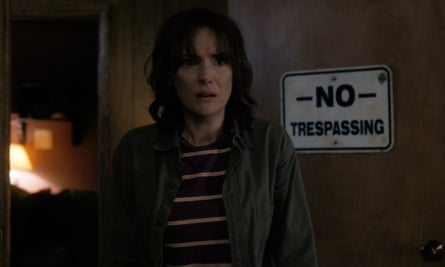There is not, usually, much to be said for growing up in the early 80s. Food – apart from Ice Magic and Space Dust – was still rubbish. Eyeshadow was neon. Clothes were so bad we knew in our bones that precious little time would be vouchsafed us before we would look back and cringe at our collective misfire.
It was a difficult decade. But there was one saving grace, to which the latest Netflix original series (just released in its eight-episode entirety) pays pitch-perfect homage. Stranger Things – set in 1983 and centred round a group of kids in the small Indiana town of Hawkins and their search for their friend Will who vanishes as he cycles home one night – channels the spirits of the celluloid storytellers who dominated the era. And it delivers a shot of nostalgia right to the viewer’s heart.
The indefatigable 12-year-old protagonists on their bikes are straight out of Spielberg – especially when they find Eleven, an almost-mute girl with large eyes and strange powers who they have to hide in the basement and who gradually learns by their example what friendship and loyalty mean.

All she lacks is a glowing fingertip and distended ribcage. Their older siblings channel the Johns; Carpenter, mostly, as the dark underbelly of the town and its government research lab that has possibly birthed a monster are gradually revealed, plus a touch of Hughes in the lighter romantic moments, as pretty girl Nancy gets the jock-with-a-heart she yearns for, but is also drawn to sensitive, misunderstood Jonathan – the boy from the wrong side of the tracks and brother of the missing Will.
The rest is Stephen King. A faceless, straggly-limbed embodiment of evil stalks their little land, roused by blood and teenage sexual activity. It is being hunted by a malevolent doctor and is stoppable only by telekinetic powers emanating from unlikely places.

Stranger Things is fun for almost all the family, depending on your juvenile cohorts’ response to occasional gory scenes. The pace is (just about) fast enough to keep younger viewers hooked, and anyone old enough to remember 1983 for real is in for a richly enjoyable retro-feast whose cockle-warming abilities make up for (what is for us) a slightly predictable narrative and inadequate explanation of the underlying mythology by the end. All the necessary ingredients are here: spooky woods, walkie-talkies as the bleeding edge of technology, nosebleeds as a sign of violent mental effort, lost spirits communicating through mains electricity and crackling phonelines, elasticated walls through which desperate hands and screaming faces push, and plain friends doomed to bloody deaths in the furtherance of plot.

AND – as Will’s mother Joyce – there is 80s-and-early-90s queen, the former Heather herself, Winona Ryder, in one of the few high profile roles she has undertaken since that whole shoplifting thing a decade and a half ago. She doesn’t have a lot to do other than be hysterical with grief and persistently regarded with a wary eye by family and local cops as she tries to talk to her son through the light fittings. But Ryder shoulders these unavoidable responsibilities with aplomb, despite being hampered by the worst wig ever seen on a human woman.
So to does Matthew Modine, erstwhile star of 1984’s Birdy and The Hotel New Hampshire, playing The Baddie (Dr Brenner, who runs the lab and who figures prominently in all of Eleven’s terrified flashbacks to her life therein). Narrowed eyes and the occasional chilling smile are, naturally, all that is required. His terrible wig is grey with just the hint of a ghost of incipient mullet which, children, is just how it should be.
All the child actors – especially Millie Bobby Brown as the forlorn ex-lab rat Eleven – are so good that they confirm my theory that Area 51 has nothing to do with aliens, but is the place where Hollywood farms its juvenile leads. Just as Eleven was apparently plucked from her mentally-unstable mother’s womb by Brenner’s team of sinister scientists 12 years ago, so children all over America are whisked off the minute they show the slightest ability to hit a mark to the Dakota Fanning School of Weirdly Automated Instinct (formerly the Shirley Temple Charm School) and drilled in the art of sitcom, drama and film under a regime that would make even Soviet gymnasts balk.

Millie Bobby Brown also does her bit to telescope time for the aged viewer by looking like a combination of a young Ryder and Stand By Me’s Wil Wheaton. The years come crashing down around your ears every time she appears on screen.
Stranger Things ends with enough tentacles inching forwards to trap another series in their creepy, creeping path. Molly, Ally, Emilio, Judd, Jennifer, Kevin, Andrew, Demi, Cusacks all – stand by your phones.
Stranger Things is available on Netflix now.

Comments (…)
Sign in or create your Guardian account to join the discussion